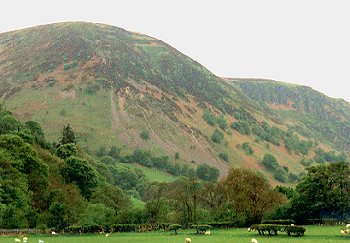
Cymraeg / English

|
Tanat Valley Historic Landscape |

|
Character area map |
Historic Landscape Characterisation
The Tanat Valley:
Hafod Hir, Llangynog, Powys
(HLCA 1015)
Steep slopes and crags and rocky hilltops above and between Cwm Pennant and Cwm Rhiwarth, with abandoned fields on lower slopes and flatter land higher up, 19th-century partitioning of upland commons, sheepfolds

Historic background
The area formed part of the upland commons of the medieval ecclesiastical parishes of the Llangynog and the upper portion of Pennant Melangell, which were merged in the 19th century. It fell within the commote of Mochnant Uwch Rhaeadr, Montgomeryshire. The precise boundaries between these two boundaries are not fully recorded but probably ran along the axial mountain wall running along the summit of the ridge between Cwm Pennant and Cwm Rhiwarth, along Waen Bwlchymynydd.
Key historic landscape characteristics
Dramatic spines of upland between deeply glaciated valleys, together with steep upper sides of valleys with crags and screes in places, between a height of between about 250-580m OD.
Present-day land-use is predominantly rough upland grazing, with extensive bracken. Stone sheepfolds towards the summit of the hill and on the trackways leading up from the lowland farms, particularly up Cwm Nantewyn near the head of Cwm Pennant and the stream valleys at the head of Cwm Rhiwarth. Some sheepfolds are probably of early date, the one at the top of the hill-slope overlooking Cwm Pennant at Merddyn Ficar (vicar's ruin) is first mentioned in a church terrier of 1772 when a stone structure at the site was already ruinous. It lies at the top of a remarkable, extensive area of bracken abandoned fields and scattered long-huts on the south-facing slopes of Cwm Pennant, above Llechwedd-y-garth, represented by field banks and lynchets, of possible late medieval to early post-medieval date.
Religions associations include the Ffynnon Cwm-ewyn holy well, on the hillside just over 0.5km to the north of the church.
Sources
Britnell 1994aEvans 1994
For further information please contact the Clwyd-Powys Archaeological Trust at this address, or link to the Countryside Council for Wales' web site at www.ccw.gov.uk.
Privacy and cookies